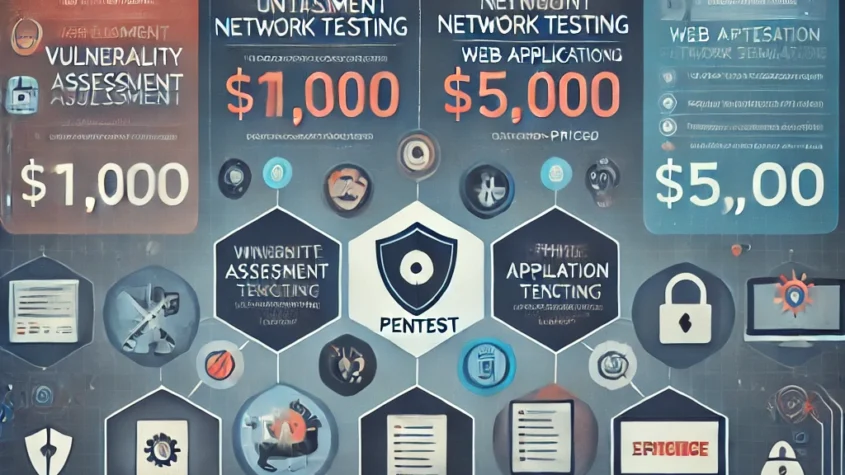
Penetration testing is an essential component of cybersecurity that helps organizations identify vulnerabilities before they can be exploited by malicious actors. The cost of penetration testing can vary widely based on several factors, including the complexity of the system, the scope of the engagement, and the experience of the testing team. Understanding these pricing dynamics is crucial for businesses looking to allocate resources effectively and ensure robust protection against cyber threats.
Typically, penetration test pricing can range from a few thousand dollars for small-scale tests to tens of thousands for comprehensive assessments covering extensive networks or applications. Factors that influence pricing include the specific type of penetration test conducted, such as web application testing, network testing, or social engineering assessments. Organizations should consider not only the cost but also the value derived from identifying and mitigating potential risks.
Evaluating penetration test pricing requires a careful analysis of both immediate costs and long-term protection benefits. Conducting thorough research and comparing providers can lead to better decision-making and investment in stronger cybersecurity measures.
Fundamentals of Penetration Test Pricing
Penetration test pricing varies widely based on multiple factors, including the type of test, the specific requirements of the organization, and the chosen pricing model. Understanding these elements is essential for making informed decisions.
Types of Penetration Tests
Different types of penetration tests can significantly influence pricing. Common types include:
- Network Penetration Testing: Focuses on identifying vulnerabilities in network infrastructure.
- Web Application Testing: Targets web applications to find security flaws.
- Mobile Application Testing: Evaluates the security of mobile applications.
- Social Engineering Tests: Assesses the human element in security through tactics like phishing.
Each type requires specialized skills and methodologies, affecting the overall cost. Complexity and scope will also play a role in determining the final price.
Factors Influencing Cost
Several factors impact the cost of penetration testing. These include:
- Scope of the Test: A broader scope typically means higher costs.
- Duration: Longer engagements result in more hours billed, increasing costs.
- Expertise Required: Specialized skills or experience can lead to higher fees.
- Certifications and Reputation: Established firms with certifications may charge a premium.
Organizations should assess these variables to align penetration testing services with their budget and security goals.
Pricing Models
Penetration testing firms employ various pricing models, which can affect total expenditure:
- Fixed Price: A set fee for a predefined scope of work.
- Hourly Rate: Charges based on the number of hours worked, offering flexibility but variable total costs.
- Value-Based Pricing: Fees based on the perceived value of the findings and recommendations.
Selecting the appropriate pricing model is crucial, as it affects budgeting and the overall impact of the penetration test on the organization’s security posture.
Budgeting for Penetration Testing
Effective budgeting for penetration testing requires understanding cost ranges, evaluating the return on investment, and engaging in negotiations. This process ensures that organizations can allocate resources effectively while maximizing security benefits.
Average Cost Ranges
Penetration testing costs can vary significantly based on several factors, including the scope, complexity, and methodology. Typical costs can range from $4,000 to $50,000 per test. The variation often depends on the following aspects:
- Scope: Tests covering larger networks or multiple applications will naturally cost more.
- Complexity: Applications with sophisticated security measures may require more in-depth analysis, increasing costs.
- Expertise: Vendors with a strong reputation or specialized skills may charge a premium for their services.
When planning a budget, it is essential to obtain quotes from multiple providers to get a sense of pricing specific to the organization’s needs.
Cost-Benefit Analysis
Conducting a cost-benefit analysis helps organizations determine the value of penetration testing against its costs. This analysis can include:
- Risk Reduction: Identifying vulnerabilities early can prevent data breaches, which often cost companies more in recovery and reputational damage.
- Regulatory Compliance: Ensuring security measures meet compliance standards can avoid hefty fines.
- Stakeholder Confidence: Regular testing can assure stakeholders of the organization’s commitment to cybersecurity.
Ultimately, an effective analysis calculates the potential financial impact of not conducting tests versus the upfront investment in testing services.
Negotiating Test Prices
Negotiating with service providers can lead to significant cost savings. Here are some strategies:
- Request Proposals: Collect detailed proposals from several vendors to compare offerings comprehensively.
- Consider Bundling: Combining multiple tests or services may allow for discounts.
- Be Transparent: Sharing specific needs with vendors may lead them to propose tailored, cost-effective solutions.
Establishing a relationship with a chosen vendor may also lead to better pricing in the long run. It is advisable to explore both short-term and long-term contracts for potential savings.
Standing Desk Canada: The Benefits and Options for Healthier Workspaces
The rise of remote work has led many individuals in Canada to explore the advantages of st…








